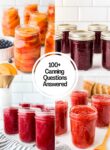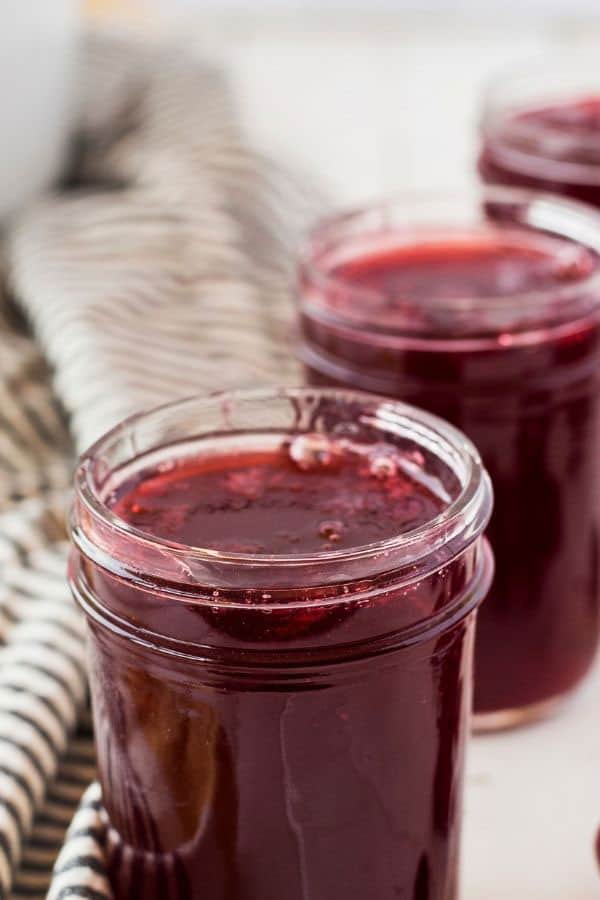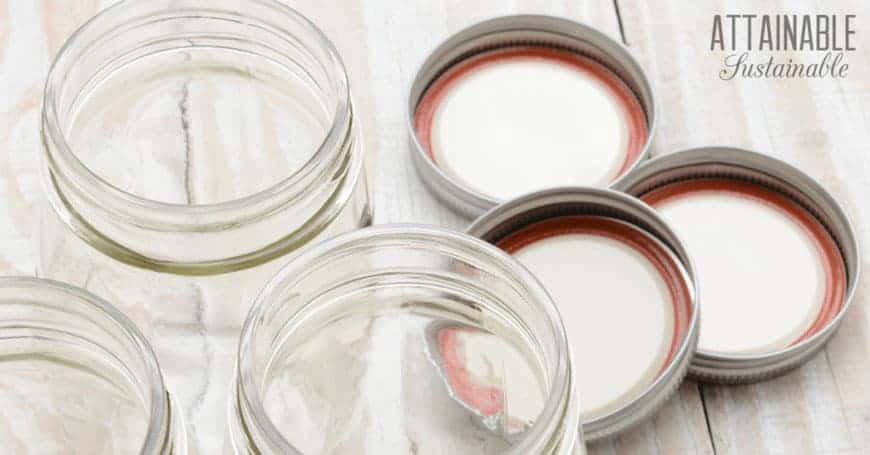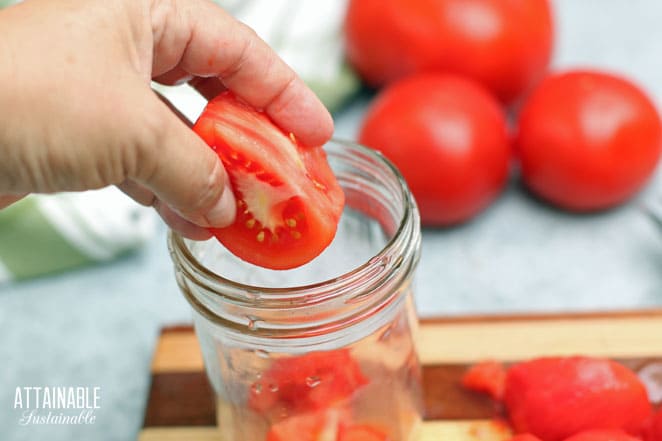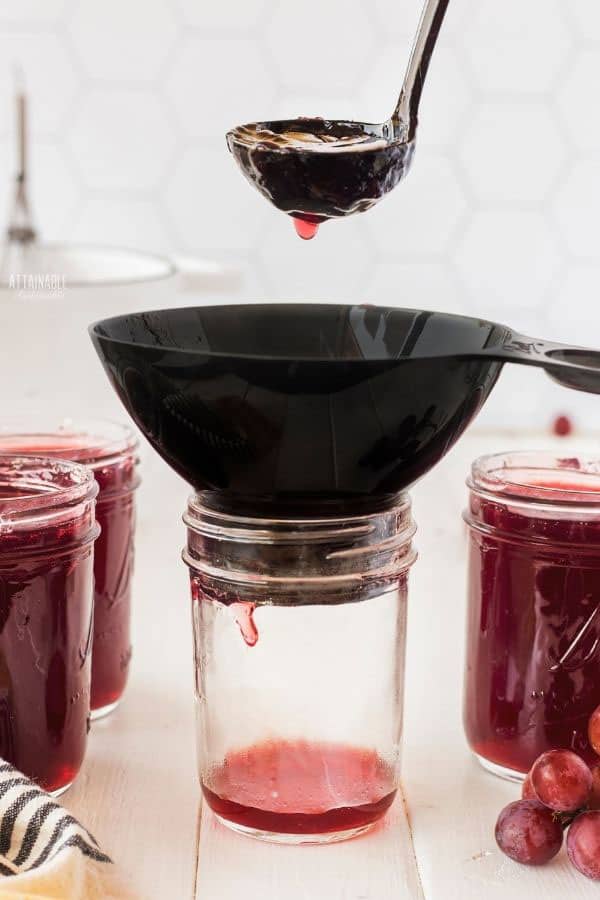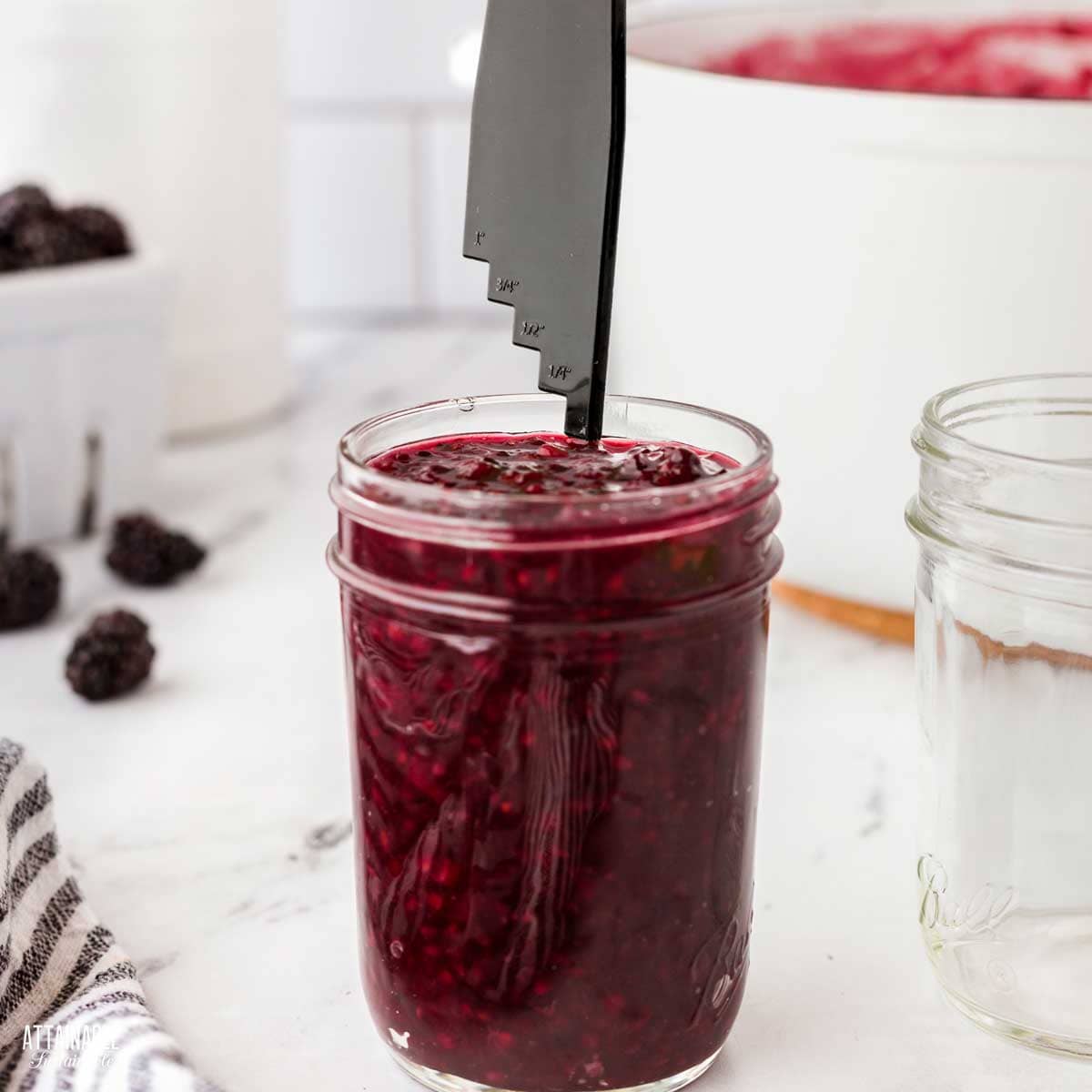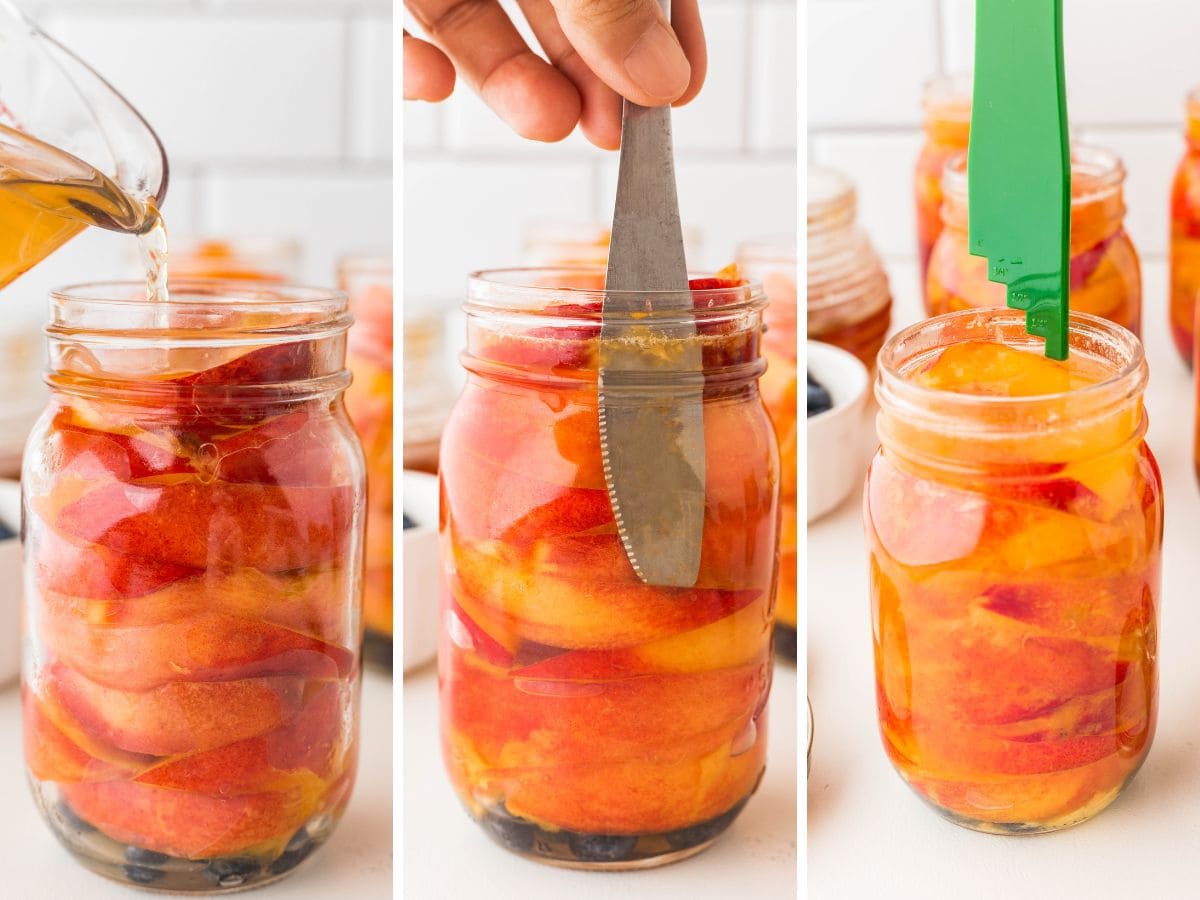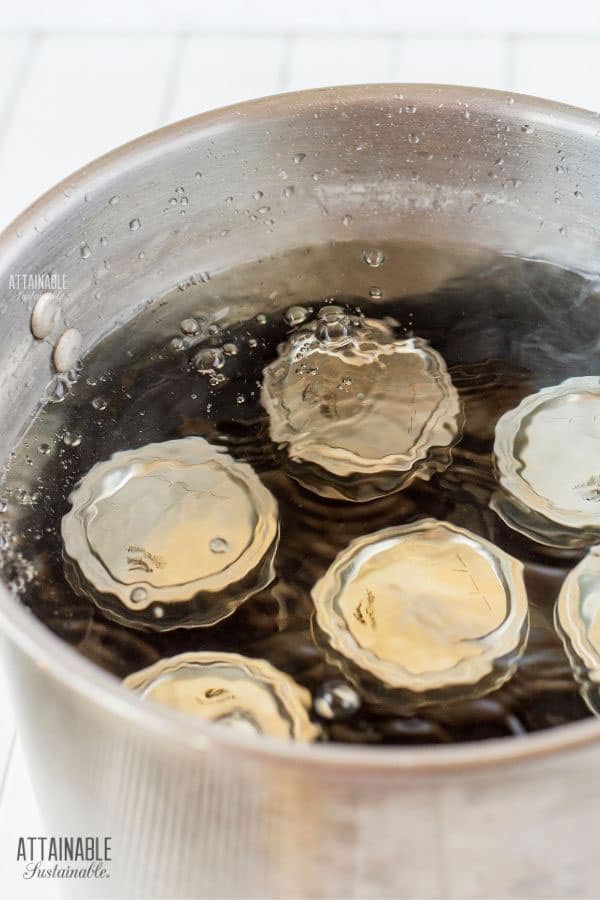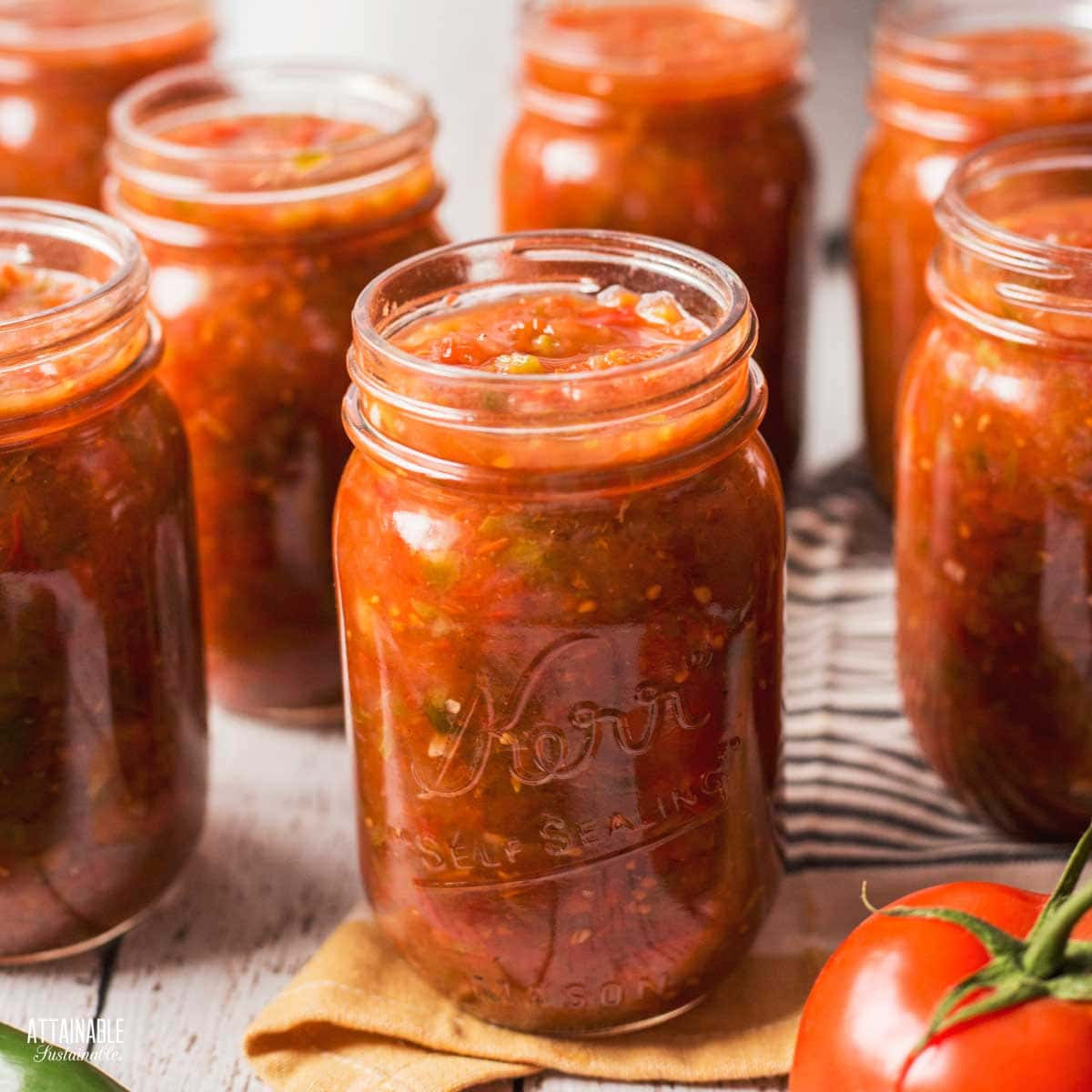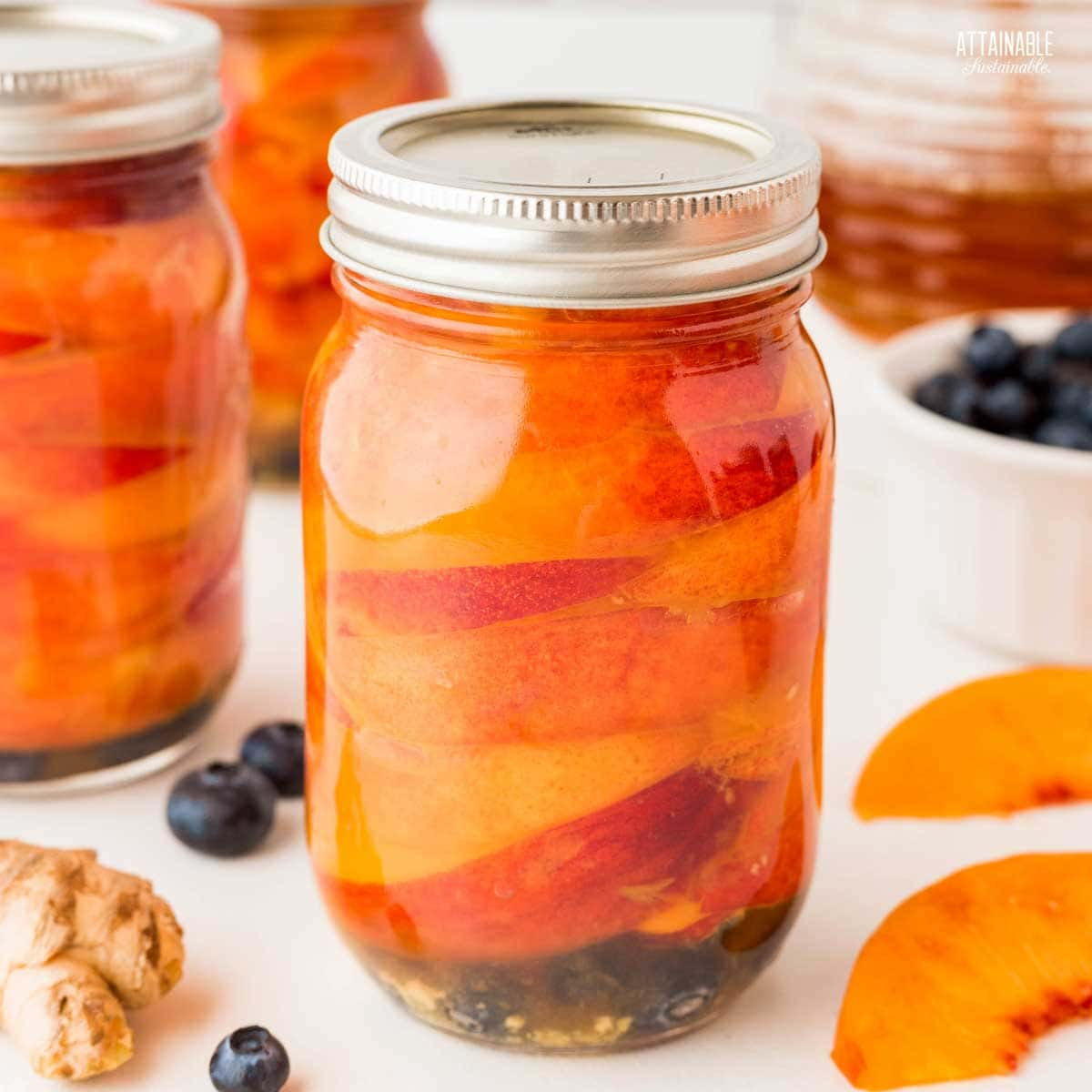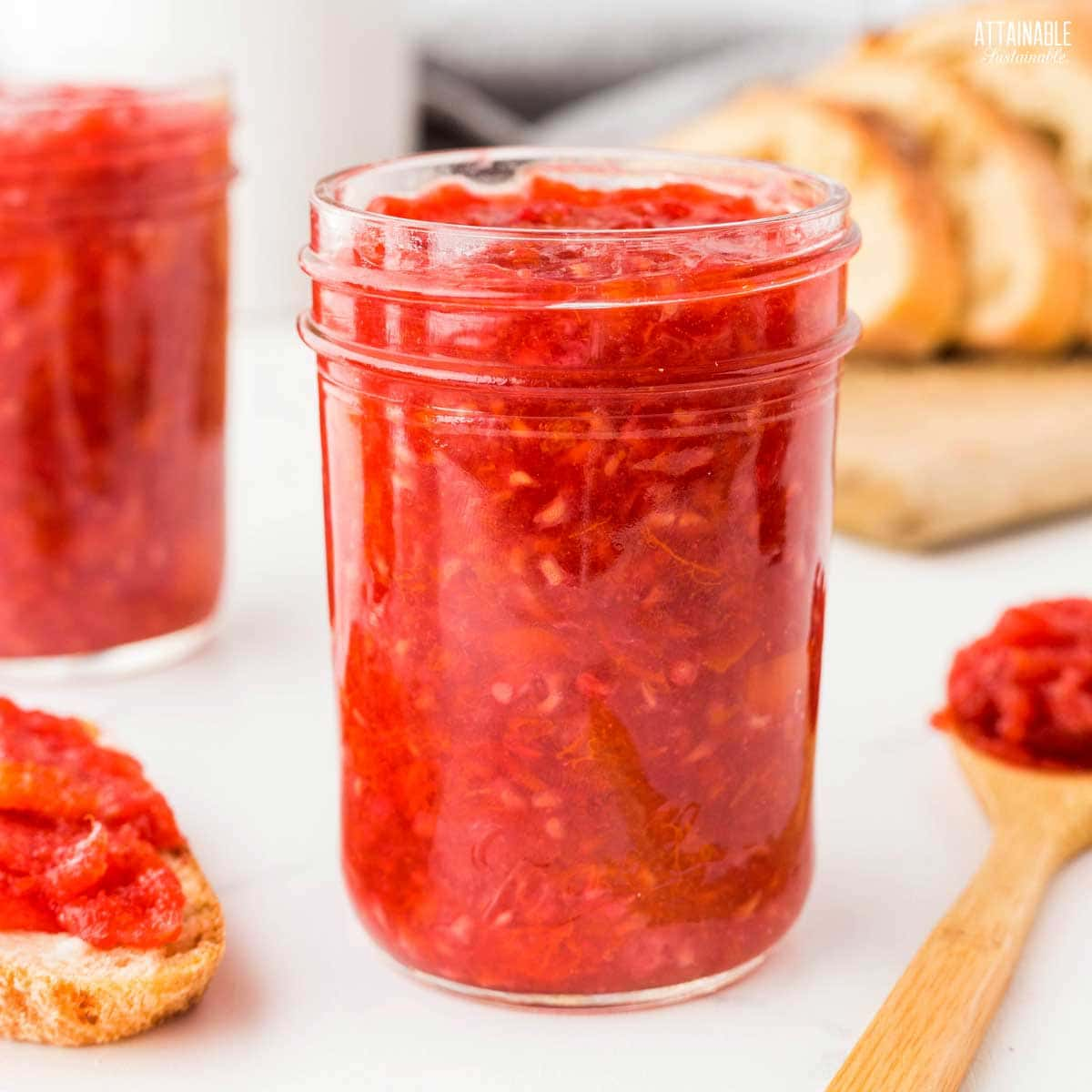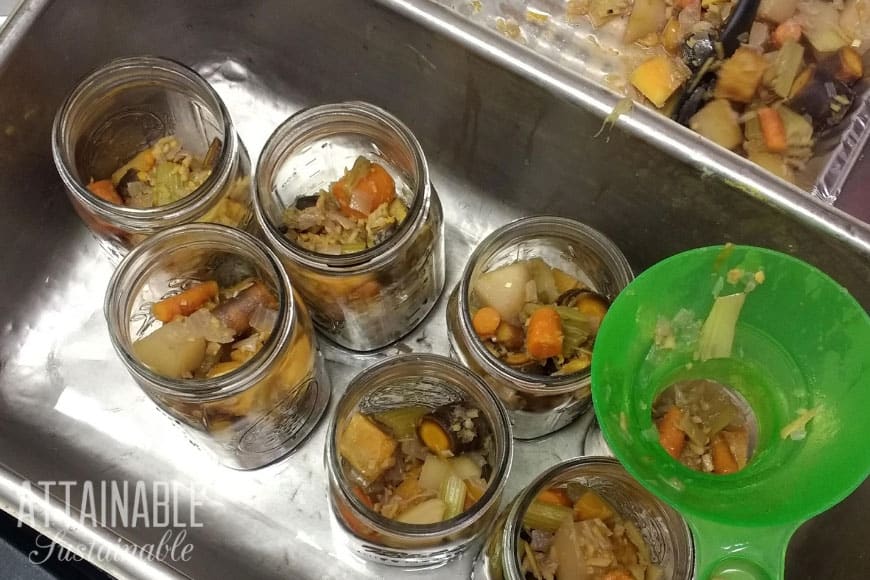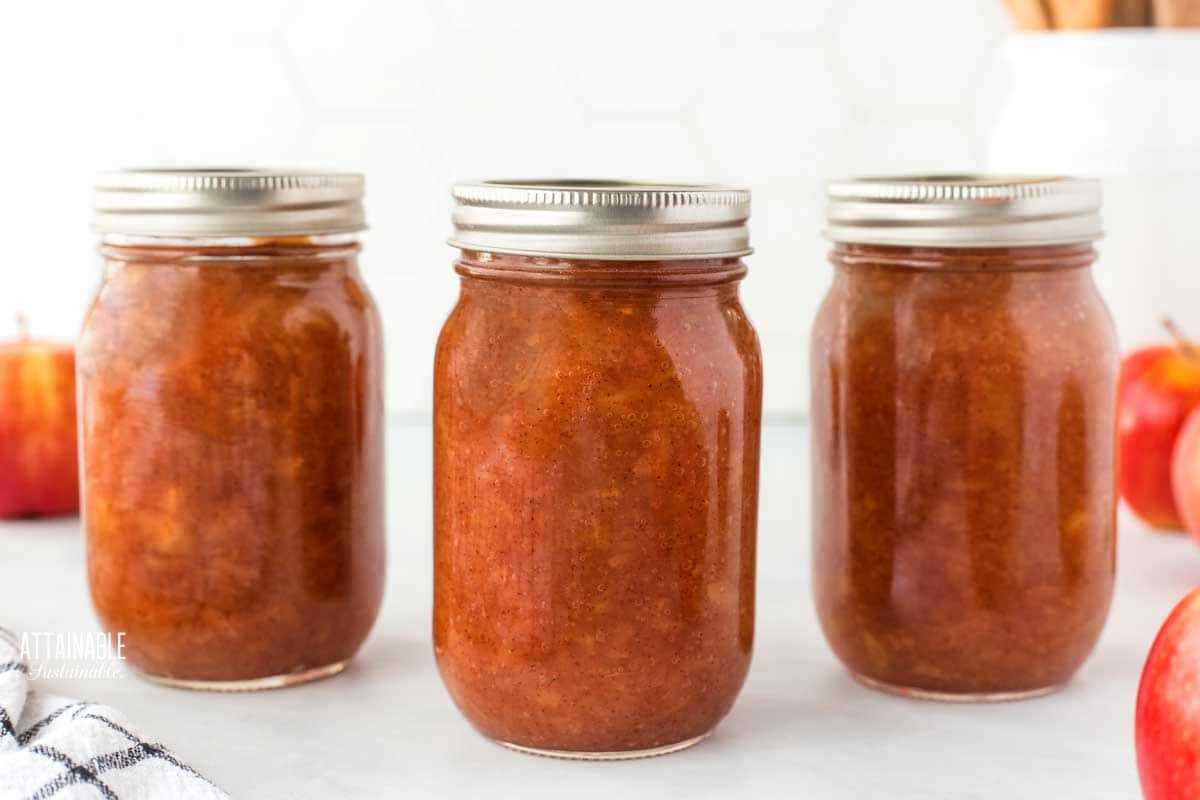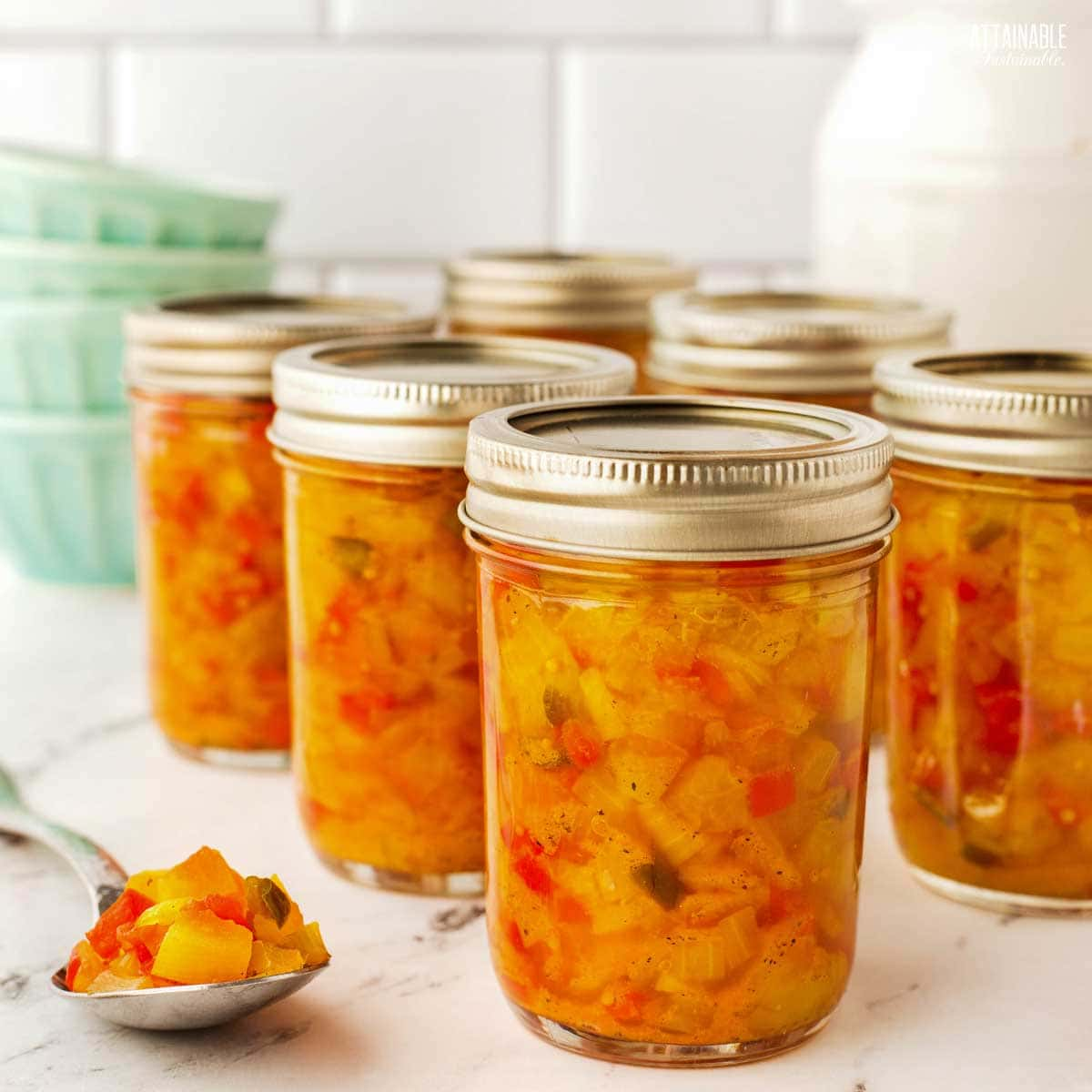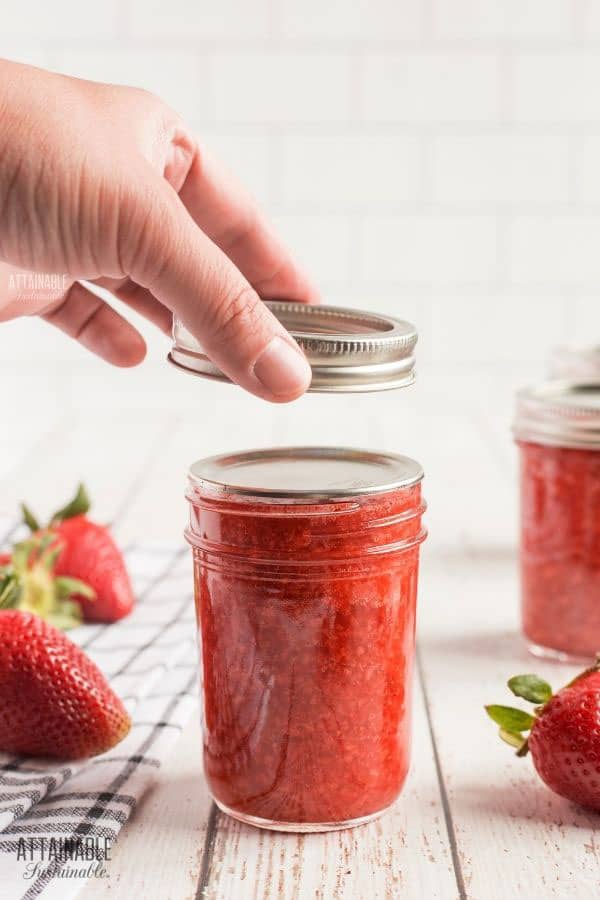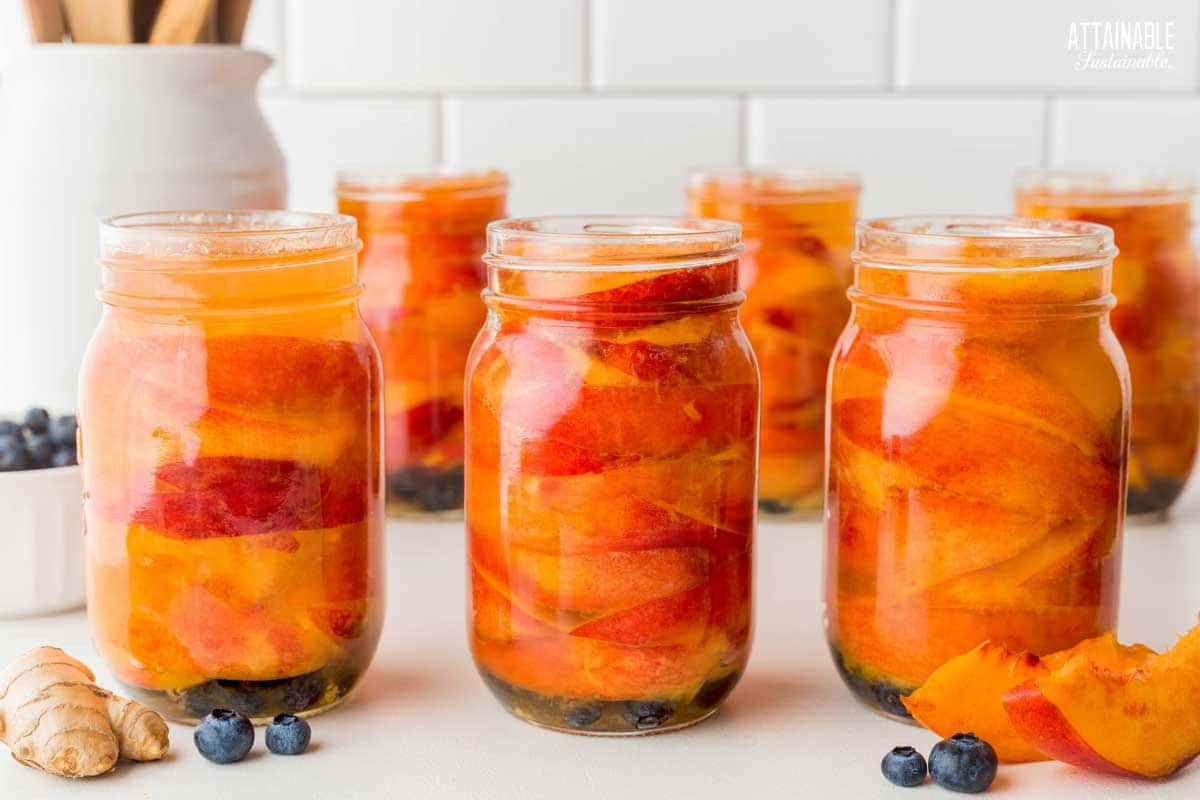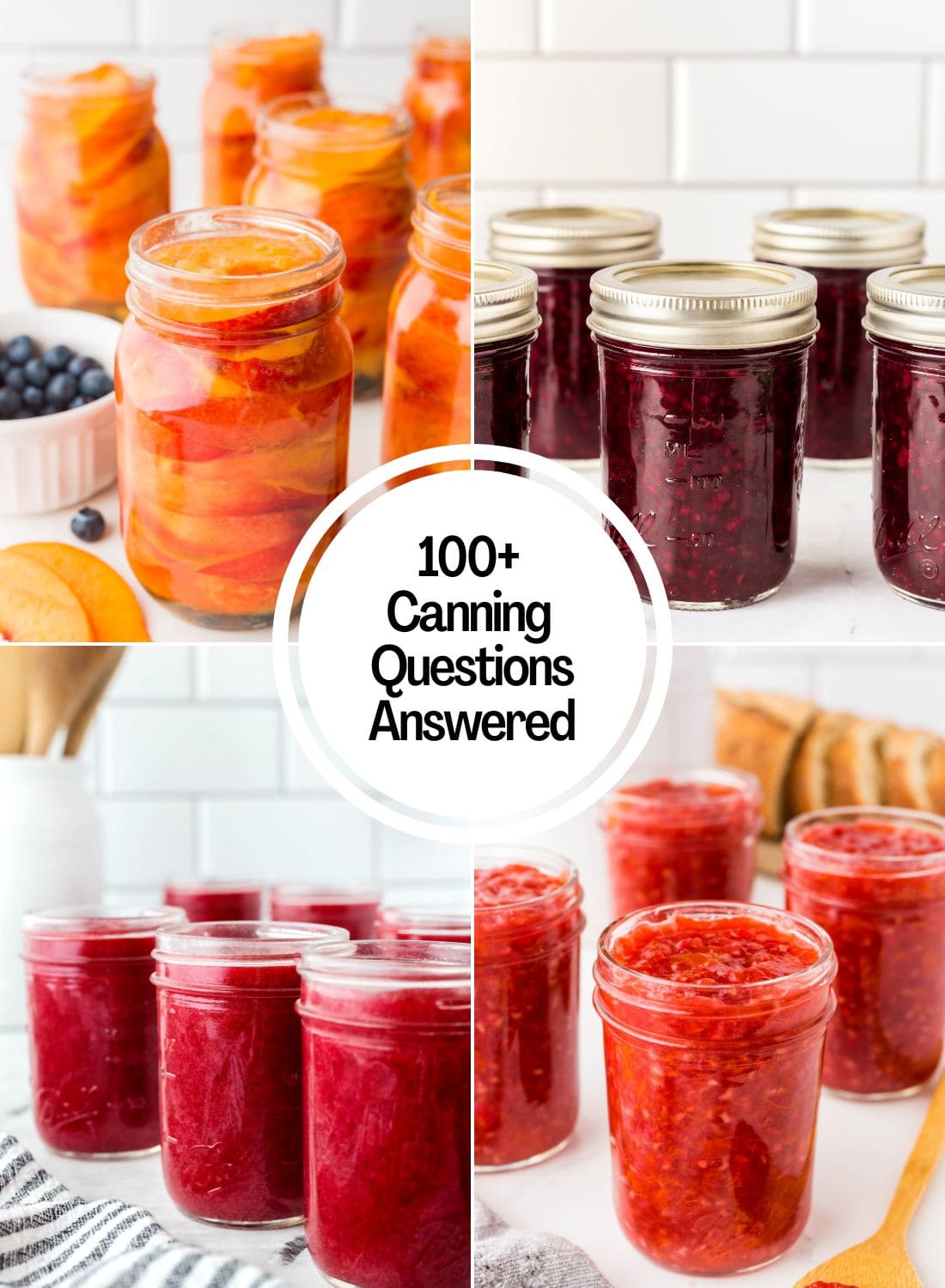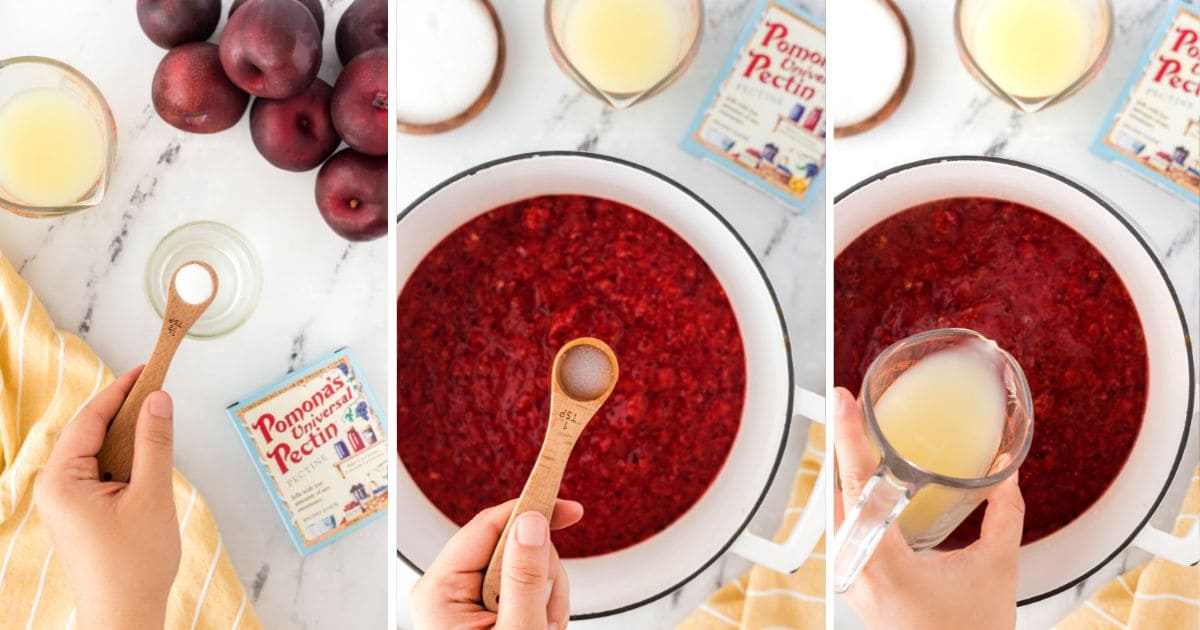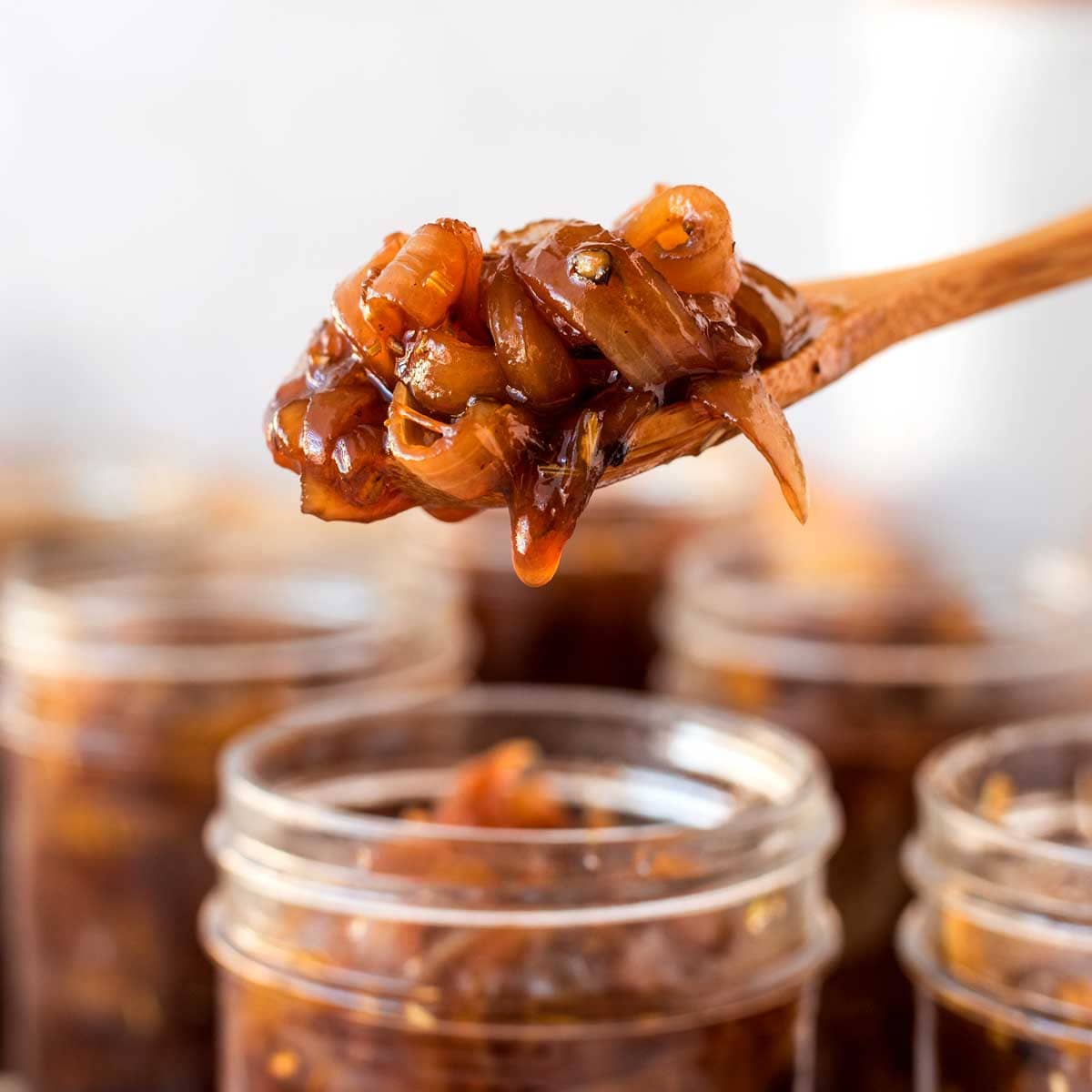As the science of food safety has evolved, so too have requirements and recommendations for home canning. I’ve been canning food at home since before I was an adult. But because I’m sharing recipes with the public, I’ve taken the time to complete my Master Food Preserver certification, to be sure that I’m sharing only best practices with you all!
This page is a giant collection of frequently asked canning questions. Have one to add? Drop it in the comments below!
JUMP TO:
- Types of Canning
- Canning Equipment
- Questions About Recipes
- Filling the Jars
- Cleaning and Sterilizing
- Processing in a Water Bath
- Sealing Questions
- Safety Questions
- Salt, Sugar, and Acid Questions
- Storage Questions
- Questions About Specific Foods
- Jams, Jellies, and Pectin
- Troubleshooting
Types of Canning
There are a number of different canning methods, each with its merits. The first thing to think about is canning safety: you must use the proper method of processing jars for the specific product you’re preserving.
What is water bath canning?
Water bath canning is the process of heating filled jars in boiling water. This method is recommended for processing acidic foods, including fruits, tomatoes (acidified), pickles, relishes, and chutney. Fruit spreads are also processed using this method. You can read more about how to get started with this method here.
Can you do water bath canning on a glass top stove?
This is the million dollar question. Some stove manufacturers advise against it, likely because of the potential for these heavy pots to damage the smooth cooktop. Another concern is the cycling of the burners. If they get too hot, some models will cycle off to prevent overheating. This on and off cycle can impact the processing, causing the water temperature to fluctuate. If you do decide to try this, use a pot that has a flat bottom. Most canners do NOT have a flat bottom, and this can make it hard to maintain the necessary heat.
Final answer: Check with your stove manufacturer and then be mindful of the problems addressed above.
What is steam canning?
The steam canning method can be used much like a water bath canning pot. Recently approved for home canning, steam canners use substantially less water than a water bath canner and heat up much more quickly. These canners have a shallow base that is filled with water. Jars sit on a rack above the water and a deep lid sits in place above them, retaining the hot steam.
What is pressure canning?
Pressure canning is the only safe way to process low acid foods like vegetables, meats, soups, and broths. These foods can harbor botulism spores if not processed properly. This method requires a pressure canner (not an electric pressure cooker!), a specialized piece of canning equipment. While a boiling water bath can reach 212ºF (at sea level), a pressure canner reaches 240ºF, which is enough heat to kill botulism spores.
What is open kettle canning and is it safe?
Open kettle canning calls for heating the product to a boil, transferring it to jars, and screwing on a lid. Instead of processing the jars in a water bath, this method is often coupled with inversion canning. These products are not actually processed or canned and it is NOT a safe method for preserving foods — even if your mom or grandma used to do this.
What is inversion canning and is it safe?
This method calls for filling jars with hot products, screwing on a lid, and inverting the jar. The thought is that hot food in the upside-down jar will heat the lid, kill any potential bacteria, and aid in sealing.
Inversion canning may result in a seal, but it will be a weak seal that may come unsealed in the pantry. Without the vacuum created with the heat processing of a water bath, there’s potential that some air remains in the jar; that air can allow for the growth of mold. Inversion canning is NOT a safe method for preserving foods.
Canning 101: Equipment and Getting Started
Canning at home requires that you have some basic equipment. Much of this equipment can be used from year to year, so consider it an investment.
What equipment do I need to start canning as a beginner?
You’ll need specialized jars, lids, and rings in which to put your home canned items, as well as a jar lifter to move the jars in and out of the canner. Other equipment — such as a canning pot — can be considered helpful but optional, since small batches of many canned goods can be made in a large stock pot. Read more about canning equipment here.
As you delve more deeply into canning, you may wish to invest in equipment for pressure canning, which I’ll cover below.
What types of jars are required for canning?
You cannot use just any jar for preserving food. You’ll need to invest in glass canning jars. You might hear a canning jar referred to as a Mason jar, after a vintage brand. The most commonly used brand of jars currently is Ball.
These jars be washed and reused from year to year. Canning jars come in both a standard or wide mouth, referring to the size of the jar’s opening. Wide mouth jars are useful for preserving larger items like peach halves or for pickles that need to be placed in the jar by hand. Read more about canning jar sizes and uses here.
What size jars are best for canning?
Canning jars come in a variety of sizes, from small four-ounce jelly jars to half-gallon sized. The small sizes are good for jams and jellies, especially those that you plan to give as gifts.
Use the jar size recommended in the recipe you’re making, with this exception: You can safely go down a size, but never up. Process jars for the original time called for in the recipe.
Can you use half gallon jars for canning?
There are only two items considered safe for canning in the large half-gallon sized jars: apple juice and grape juice.
Are bands and rings the same thing?
Yes, the terms are used interchangeably to indicate the threaded part of the two-piece lid system that holds the flat portion in place for processing.
Can I reuse lids or rings?
The rings (or bands) can be reused indefinitely, unless they begin to rust. Metal canning lids cannot be reused for home preservation. Once a lid has been used, the seal becomes compressed and it will be more difficult to get the necessary airtight seal.
You must purchase new lids for each new canning project. Lids are sold in sets of twelve and can be purchased separately from jars and rings.
The plastic lids made by Tattler can be reused. They come in two pieces — a plastic disk and a rubber ring. Tattler canning lids are BPA-free and can be reused from year to year.
Canning Food: Questions About Recipes
The most important thing to know about canning recipes is that you should choose recipes from a reputable source. There are a lot of recipes on the internet, some of which use questionable methods. I am a certified Master Food Preserver and only share recipes made using safe and approved methods.
What are the easiest foods for beginners to preserve?
I like to suggest that people start with jam and jelly. Because they are acidic, they can be processed in a water bath safely. Other recipes that are safe for water bath canning include canned fruits and some tomato products.
Read more about canning jams and jellies in this step-by-step guide.
Why must I acidify tomatoes?
The pH level of fresh tomatoes can vary depending on the variety and ripeness. To be sure that tomato recipes for canning fall within the safe zone for water bath canning, it’s common to see tomato recipes acidified with vinegar, lemon juice, or citric acid. If a recipe calls for added acid, it’s important to use it. Read more about canning tomatoes here.
Can I adjust a canning recipe?
Recipes for home canning have been developed to be safe for canning, with a very specific pH. Changes made to any recipe can alter the pH. It’s critical that canning recipes be followed exactly and that you choose recipes from a reputable source.
I’m a certified Master Food Preserver and I follow current safe canning guidelines for all of my canning recipes. Other reputable sources include Ball and the National Center for Home Food Preservation.
So what’s this pH thing about?
The pH of a recipe is what allows canners to determine if it’s safe to be preserved via the water bath canning method. In most of America, a pH of 4.6 and below is considered to be safe for water bath canning. In Hawai‘i, the recommendation is 4.2 and below.
Canning recipes developed by trusted sources like the National Center for Home Food Preservation take this into consideration when determining the safety of a recipe. Recipes that do not fall within those guidelines are NOT safe for water bath canning.
Can I double a canning recipe?
In most cases, as long as you’re confident about the accuracy of the math, you can. You’ll need to adjust the number of jars you use, and you may need to process in batches, since you’ll be limited on how many jars fit in the water bath canner.
It is not recommended that you double recipes for jam and jelly, as adjusting the recipe may interfere with the gelling of the product.
How do I adjust a recipe for altitude?
This varies based on what you’re canning and recipes should indicate how much to increase processing time (or pressure in the case of pressure canning). If they don’t, refer to this information from the South Dakota State University Extension.
Does jar size affect canning time?
Absolutely. Quart-size jars often require a longer processing time than smaller jars. Always follow the recommended time in your recipe.
What is the difference between canning and pickling?
Canning is the process of making a jarred product shelf stable. Pickles are vegetables preserved in vinegar. Pickled veggies can be processed to be shelf stable (like these pickled green beans), but it’s not necessary. Refrigerator pickles are not shelf stable and must be kept cool.
Filling the Jars
Remember Goldilocks? Filling jars has a little bit of that “juuuust right” vibe. Follow the recipe as it’s written. The information in the recipe is there for a reason.
What is the difference between hot pack and cold pack?
Hot packing calls for heating the food product before transferring it to jars, such as with my salsa recipe for canning. Foods like peaches or cucumbers for pickling are often packed into canning jars while raw, then covered with a boiling liquid.
What is headspace (and how much do I need)?
Headspace is the measurement between the level of the food in the jar and the jar rim. How much headspace to leave should be spelled out in each recipe but will vary from 1/4″ (common for jam and jelly) to 1″ (seen in many pressure canning recipes).
What happens when you leave too much headspace when canning?
The called-for processing time may not be long enough push out the excess air, and a vacuum seal may not form. The air inside jars should be completely expelled during processing to help create the sterile environment needed for safe long-term storage.
What if you don’t leave enough headspace when canning?
The contents of the jar may boil out. This is problematic because food particles could be caught between the jar rim and the lid, again preventing a successful seal.
What happens if there are air bubbles when canning?
When there are pockets of air left in the jar, they can interfere with proper sealing. As with too much headspace, air bubbles left in the jar can make it hard for the jar to push out all of the excess air for a good seal.
It can also mean that as the liquid in the jar bubbles during processing, the air bubbles will rise to the top, resulting in the level of the canning liquid becoming too low, exposing the food product. This can lead to discoloration, which is unattractive but still safe to eat.
How do you get rid of air bubbles?
There are special bubble removing tools (often coupled with a headspace tool) that you can use, but a plastic knife or silicone spatula works as well. Do not use a metal knife, as they can scratch the inside of the glass jar and weaken it.
To use these tools, work your way around the jar, sliding them down inside the glass to release any visible air bubbles.
Why is it important to wipe the rims?
Food residue on the jar rim can impede sealing. Use a clean damp cloth to wipe the jar rims before placing the lids on the jar. A clean rim is essential to a good seal.
What’s the purpose of a canning ring?
The canning ring — or band — holds the flat lid in place during processing.
Why do you remove the rings after canning?
Leaving the rings on during storage will prevent you from seeing that a jar lid has come unsealed.
How tight should rings be when canning?
The lids need to be held securely in place with the ring. You don’t need brute force for this, but the rings should feel tight on the jar. Putting the rings on too tight can compress the sealing compound too much, and prevent the air inside the jar from being expelled.
What does “fingertip-tight” mean?
This is a phrase often used to describe how tight to secure the rings. Use just your fingertips and tighten the ring so that it feels good and secure.
Cleaning and Sterilizing Questions
Cleanliness when canning food for long-term storage is crucial. But what exactly does that mean?
Do jars need to be cleaned before canning?
Canning jars should be washed just prior to using them. Clean jars stored in a cupboard can be dusty or exposed to other elements.
What is the best way to clean jars?
Wash canning jars in hot soapy water, then rinse and dry.
Do I need to sterilize jars before canning?
According to the National Center for Home Food Preservation, it is not necessary to actually sterilize jars used for canning if they will be processed for 10 minutes or more. The jars will be sterilized during the canning process.
When is the right time to sterilize canning jars?
If a jar will be processed for less than 10 minutes, it is recommended that you sterilize the jars right before filling. To do this, place clean, empty jars in your canner and fill with enough water to cover the jars by an inch. Boil for 10 minutes at elevations lower than 1,000 feet. Add an extra minute for each additional 1,000’ of elevation. When you’re ready to fill the jars for canning, use a jar lifter to remove the jar and tip the water back into the canner. The heated water in the canner is perfectly fine for processing filled jars.
How do you sterilize canning jars in the oven?
You shouldn’t. The dry heat of an oven may cause jars to shatter. It’s easy to simply sterilize jars as directed above, when the water for processing is already being heated.
Does a dishwasher sterilize canning jars?
If you have a newer dishwasher with a “sanitize” function, you can use that.
Do I need to sterilize canning lids?
Current (and somewhat new) guidelines suggest that lids do not need to be heated prior to use. Just like the canning jars, they will be sterilized during the canning process.
How do you remove scale or hard water stains from canning jars?
Soak jars for several hours in a solution of 1 cup of vinegar in a gallon of water to help remove stubborn stains. Wash with hot soapy water after soaking.
Processing the Jars in a Water Bath
As already mentioned, the water bath process is recommended for processing acidic foods, including fruits, tomatoes (acidified), pickles, relishes, and chutney.
How do I fill the water bath canner? How much water do I use?
How much water you use will depend on the size of your canning pot, how many jars you’re processing, and the size of the jars. Use as much water as necessary to cover the jars by a minimum of 1″ of water. It’s a good idea to have a kettle of hot water on hand to “top off” a load of canning in case you underestimated. (Adding cold water will lower the temperature of the water.)
Do you add jars to room temperature or boiling water?
Add filled jars to pre-heated water. For raw packed foods, preheat the water to 140ºF. For hot packed foods, preheat to 180ºF.
How hot should the water in a water bath be?
This method processes foods at boiling (212ºF). Once jars are in place, place the lid on the canner and bring the water to a boil over high heat. Once the water comes to a boil, start the timer for processing and lower heat to maintain a gentle boil for the entire processing time.
Can jars touch during canning?
Jars should be placed so that there is a little room between them. They may move during processing and rattle together a bit; this is normal. But don’t pack them tightly.
How long do I process jars?
Every recipe will have a specific processing time based on research that shows how long each needs to be heated so that all of the food in the jar hits the necessary temperature to destroy dangerous microorganisms. These times vary according to the food’s density, packing liquid, jar size, and pH, and should be followed precisely.
How long do I let jars rest after canning?
Once the processing time has elapsed, use a jar lifter to move the hot jars to a draft-free countertop. Allow the jars to cool naturally to room temperature before checking the seals.
Can you cool jars under running water?
Absolutely not. Exposing hot jars to cool water is likely to crack the glass.
Is oven canning safe?
No. The dry heat of an oven may cause jars to shatter. But more importantly, the transfer of heat in an oven is different than in a water bath canner and the food inside the jars may not reach the necessary temperature for safe storage.
Sealing Questions
The vacuum seal on a canning jar is what keeps the food inside safe to eat. It’s critical that jars are sealed properly after the end of the appropriate canning process.
How do you know if jars are sealed correctly?
When a jar is properly sealed, the metal lid will feel solid and it will not flex when pushed.
Tattler reusable lids are tested by using your finger tips to lift a cooled jar by the lid. The weight of the jar itself — and gravity — help determine a safe seal. If the lid remains on and sealed tightly when held slightly above the countertop, it’s considered sealed.
How long does it take canning lids to seal?
Sometimes they’ll give that little “tink” sound of a sealing lid as soon as they are pulled from the canner. Other times, it can take 30 minutes for the jars to seal after coming out of the water. Jars should be allowed to sit at room temperature until completely cooled before you remove the rings or touch the lids, even if they appear to be sealed.
What is a false seal?
A false seal is a jar that looks sealed, but due to improper canning techniques, has a weak seal. Once in storage the lid can come unsealed, allowing bacteria to enter the jar. Make sure you wipe the rims well, use proper headspace, and avoid open kettle canning to avoid a false or weak seal.
Can I reprocess jars that didn’t seal?
You can, yes. Transfer contents of the jar to a clean jar and use a new lid, then process according to directions. Reprocessing of jars needs to occur within 24 hours of the original effort. Refrigerate jars until you’re ready to do so, then reheat the product and process according to the original instructions, using a new jar and new lid.
I find it’s really not worth the time and will just keep unsealed jars in the fridge and use them right away.
Safety Questions
What foods are not safe to can?
Dairy products should never be canned. This means creamed soups, too.
- The exception: this lemon curd recipe has been deemed safe and it includes butter.
Eggs (plain or pickled) should not be canned.
- The exception: the lemon curd recipe linked above.
Oil or products preserved in oil should not be canned and you should never add extra oil to tested recipes. Even if your grandma did it.
Pasta and rice are starchy food products, which can impact the heat transfer inside jars. Not to mention, they would be absolute mush after processing.
Starches can, again, impact the heat transfer inside jars. Using flour or cornstarch to thicken soups and stews before canning is not safe. Instead, add those ingredients once the jar has been opened and you’re heating it. Thickening products like pie filling can be done following safe canning recipes that include the use of Clear Jel® or Pomona’s Universal Pectin.
Purees like pumpkin, refried beans, and mashed potatoes are too dense for safe canning. The heat during processing cannot reach the center of the jar.
What are low acid foods?
Foods that have a pH of 4.6 or higher are considered low acid foods and MUST be processed in a pressure canner to kill botulism spores. This includes meat, fish, and vegetables (except those that are pickled).
Can you pressure can low acid foods?
Pressure canning is the only safe way to make low acid foods shelf stable. Always follow directions from reputable sources.
Is it safe to can homemade chili, soups, or stews?
Yes. There are a lot of opportunities for canning ready-to-heat meals. Just be sure to follow a recipe from a reliable source.
What prevents botulism in home canned foods?
The only way to prevent botulism spores from surviving in low acid foods is to process them at a temperature between 240°-250°F. A water bath canner simply cannot reach that temperature, so low acid foods must be pressure canned.
Are old-fashioned canning recipes safe to use?
The requirements and recommendations for home canning are ever-changing. If you’re following a home canning recipe from a reputable source that goes way back, it’s a good idea to “check in” on your favorite canning recipes every once in awhile to make sure the procedure is still deemed safe.
Great Granny’s canning recipes are another story. We’ve learned so much about the science of canning since Granny was putting food by. Seek out a similar recipe from a reputable source rather than relying on old-fashioned methods.
The All New Ball Book of Canning has a lot of safe and delicious recipes to choose from!
How can you tell if home canned food is still good?
Some compromised jars of food have visible signs of trouble, but the botulism toxin can be odorless and tasteless, too. Never sample a questionable product!
Signs to look for:
- A bulging lid or glass bubbles
- Mushy or gassy looking food
- Mold growing on the surface of the food or canning liquid
- Streaks of food on the outside of the jar
- A sour, rancid, or putrid odor
- Liquid or foam spurting from a container upon opening
- Low acid foods that were not prepared in a pressure canner (always ask when gifted a home canned product!)
The standard refrain is: When in doubt, throw it out.
What causes color changes in home canned foods?
There are a number of things that can cause color changes in canned goods.
- Exposure to light is one, which is why it’s recommended that you store canned goods in a cool, dark place.
- Foods that are exposed to air in the jar can discolor due to oxidization. To prevent this, be sure to remove air bubbles and check recommended headspace before sealing the jar.
- Using cooking utensils with zinc, iron, or copper can cause food products to discolor.
- Overprocessing or using immature (or over mature) produce.
Is it safe to eat discolored canned food?
If food shows discoloration at the top of the jar, it’s likely due to exposure to air in the jar. These are safe to eat even though they are not pretty. I’d recommend using those first, though.
Salt, Sugar, and Acid Questions
What salt is best for canning?
Pickling salt is labeled very specifically for pickling because it does not contain iodine or anti-caking agents. It’s absolutely perfect for pickling, but a plain sea salt or kosher salt can also stand in for your food preservation needs if you don’t want to purchase one more kind of salt.
Read more about the difference between table salt and canning salt here.
Are Kosher salt and canning salt the same?
No. Canning salt is devoid of additives and anti-caking agents that can cause cloudiness in canned goods. Kosher salt has a larger texture, but it, too, is free of additives. You can use kosher salt in canning but since it’s less salty than canning salt, you may need to increase the amount. (This is safe to do; salt is included in canning recipes solely for flavor.)
Can you use iodized salt for canning?
Iodized salt will cause canned goods to become cloudy, making an inferior product.
Can you use brown sugar in place of white sugar for canning?
Yes, it can be substituted 1:1 for granulated sugar, but it may slightly alter the flavor and color of the end product.
Can you use honey in place of sugar when canning?
When canning fruit, you may substitute honey for sugar. Honey is sweeter than sugar so you will use less.
It’s a little trickier when canning jams and jellies, as the quantity of sugar called for in recipes directly impacts the set of the fruit spread. I like to use Pomona’s Universal Pectin because it allows me to easily substitute honey for granulated sugar.
Can you use artificial sweeteners in canning?
Sugar helps preserve the color, texture and flavor of home canned foods, but it’s not necessary to safe preservation. Canned fruits can actually be packed in unsweetened water.
Sugar does play a part in the set of jams and jellies. Substituting artificial sweeteners can impact the end product; use recipes that are specifically labeled for use with these products. Alternatively, opt for products like apple butter, where no added sugar is required.
Why is acidity so important in the canning process?
It’s all about safety. Foods that have a pH of 4.6 or lower are considered high acid. These foods are safe for water bath canning, as botulism spores cannot survive in acidic conditions.
What are low acid foods?
Foods that have a pH of 4.6 or higher. These can support the growth of botulism if not properly processed in a pressure canner.
Should you test the pH levels of canned food?
If you are using safe recipes from a reputable source, you shouldn’t need to. That said, it certainly wouldn’t hurt for you to double check recipes. And as much as I say, “don’t change recipes,” if you DO, you absolutely need to test the pH. These pH papers are easy to use and can offer peace of mind.
What type of vinegar is best for canning?
You need to use a vinegar with 5% acidity.
Can you use cider vinegar or rice vinegar for canning?
Yes, absolutely. As long as it hits that 5% acidity (this should be marked on the container) you can try different vinegars. Each will provide a slightly different result.
What is the purpose of using lemon juice in canning?
Lemon juice is added to recipes to acidify the product, making it safe for water bath canning.
Do you have to use bottled lemon juice when canning?
Yes. This is due to the fact that bottled lemon juice has been uniformly acidified as required by FDA regulations: “lemon juice prepared from concentrate must have a titratable acidity content of not less than 4.5 percent, by weight, calculated as anhydrous citrus acid.”
Can I substitute citric acid for lemon juice?
Yes. Vinegar, citric acid, and lemon juice can be used interchangeably to acidify canned foods.
How much citric acid do you use for canning?
Per pint
- 1 tablespoon of bottled lemon juice
- ¼ teaspoon citric acid
- 2 tablespoons vinegar (5% acidity)
Per quart
- 2 tablespoons of bottled lemon juice
- ½ teaspoon citric acid
- 4 tablespoons vinegar (5% acidity)
What is the difference between ascorbic acid and citric acid in canning?
Ascorbic acid is used to prevent discoloration in foods (especially fruit). Citric acid is used to acidify the food for safe canning.
Storage Questions
How do you store homemade canned food?
Sealed jars should be stored in a cool, dark place with the rings removed.
What temperature is best for storing canned foods?
Temperatures between 50°-70°F is ideal.
Can you store home canned food in the garage?
If your garage maintains a steady temperature close the the range listed above, there’s no reason why not.
Should you store home canned food jars upside down?
No. When lids maintain contact with the food over long periods, the natural ingredients in the food (especially acidic foods) can corrode the lids.
How long can you store home canned foods?
Twelve to 18 months is recommended as the “best by” date. Jars kept longer than that – as long as they were properly processed and remain sealed – are still safe, though you may notice a loss of quality.
Use the first in, first out method to make sure that you’re using the oldest jars first.
How long does canned food stay good after opening?
This depends entirely upon the food. Pickles can last months after being opened. Jam and jelly should be used within a couple of weeks.
Go here for more on proper storage of canned foods.
Questions About Specific Foods
Can fruit be canned without adding extra sugar?
Sugar helps preserve the color, texture and flavor of home canned foods, but it’s not necessary to safe preservation. Canned fruits can actually be packed in unsweetened water.
Can vegetables be canned without added salt?
Yes. Salt is added purely for flavor.
Do tomatoes need to be blanched and peeled before canning?
It is recommended in the USDA Complete Guide to Home Canning that you do. Here’s why: Clostridium botulinum spores, commonly known as botulism, live in the soil and are commonly found on the surface of fresh foods. Washing produce removes some of those spores, as does blanching. Peeling removes more.
Do tomatoes always need lemon juice added during canning?
Different tomato varieties vary in acidity, some being sweeter and others more acidic. To be sure that your tomato recipe is safe for water bath canning, you should always acidify tomatoes as called for in the recipe.
Should all vegetables be precooked before canning?
Not necessarily. In canning, there are raw pack and hot pack recipes. Follow the recipe as instructed for the best results.
Why shouldn’t you can zucchini and summer squash?
These tender vegetables are low in acid and would require canning in a pressure canner. Exposed to that much heat, they would turn to mush.
- The exception: Pickles and relishes made from zucchini and summer squash can be processed in a water bath because of their acidity. This calls for a shorter processing time.
Why did my canned potatoes turn cloudy?
The starch in potatoes can cause cloudiness. Be sure to blanch the potatoes as directed and drain off the cooking water before jarring.
How do you keep pickles and other vegetables crunchy when canning?
This can be a challenge. Cucumbers in particular can get soft when processed in a water bath.
- Cut off the blossom end of the cuke to remove enzymes that can cause pickles to soften.
- Pack jars to include a grape leaf.
- Start with very fresh produce.
What types of meat can be canned?
Most meat can be canned using a pressure canning method. This can include just meat, such as canned chicken or tuna, or products like chili that include meat.
Do you have to cook meat before canning it?
Meat products can be raw packet or hot packed. Follow safe canning recipes.
Can you can fermented foods?
Just because you can doesn’t mean you should. But if you do, be sure to check that the pH of the finished product has a pH of 4.6 or lower and follow the directions here.
Does canning kill probiotics in fermented foods?
Yes. Canning fermented foods will eliminate the good-for-you probiotics.
Jams, Jellies, and Pectin Questions
Why do you use pectin when canning jams and jellies?
Pectin is what causes jams and jellies to set.
When is the best time to add pectin to jams and jellies?
It varies by manufacturer.
What happens when you add too much pectin when canning?
The jam or jelly can become too solid.
How do you fix canned jam that didn’t set?
It’s possible, but my solution is to label it “syrup” and serve it with pancakes. I find that the effort of reprocessing is just not worthwhile.
What causes crystals to form in jams and jellies?
Cooking jam or jelly at high heat can cause crystals to form on the hot sides of the pot. Cook gently.
Troubleshooting
Why are my jars sticky after canning?
You may have had boil-over or siphoning during processing; these are caused by too little headspace or inconsistent heating during the processing. Keep an eye on these jars, as residue from the boil over can remain on the lid and make a less secure seal.
What causes jars to break in a canner?
Sudden temperature changes can cause thermal shock and breakage. Bring water to about 140ºF for raw packed foods, 180ºF for hot packed foods; don’t put jars into rapidly boiling water.
Why do lids crinkle or buckle during the canning process?
Heating causes the air in jars to be pushed out; this creates a vacuum. When lids are screwed on too tight, it prevents the air in the jar from being forced out and the lids buckle.
What is siphoning and what causes it?
Siphoning is when liquid is drawn out of the jar during processing. Food expands when it is heated. When too little headspace is allowed, the expansion of the food forces liquid out of the jar. This impacts the amount of liquid in the jar, but food lodged between the rim of the jar and the sealing compound can also cause seal failure.
What causes loss of liquid during the canning process?
Siphoning. This can be caused by rapid temperature changes or improper headspace.
Does lost liquid need to be replaced?
If the liquid level remains above the halfway mark of the jar, it is a sufficient amount of liquid. When the liquid level is less than that, you should put the jars into the fridge once they’ve cooled and use them right away.
If the food products inside a sealed jar are exposed to the air in the jar, they can begin to darken, but they are safe to eat. Just put them at the front of the queue.
How do you keep canning rings from rusting?
Dry them well and store them in an airtight container. Even so, after time they will need to be replaced.
What causes discoloration on metal canning lids?
The natural acidity of foods can cause the inside of the lid to discolor. Don’t store lids upside down and this shouldn’t be a problem.
